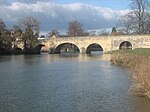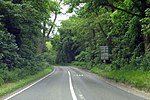Crowmarsh Gifford
Former civil parishes in OxfordshirePopulated places on the River ThamesSouth Oxfordshire DistrictUse British English from August 2015Villages in Oxfordshire ... and 1 more
Wallingford, Oxfordshire

Crowmarsh Gifford, commonly known as Crowmarsh, is a village in the civil parish of Crowmarsh, in the South Oxfordshire district, in the county of Oxfordshire, England. It is beside the River Thames opposite the market town of Wallingford, the two linked by Wallingford Bridge. Crowmarsh parish also includes the hamlet of Newnham Murren, which is now merged with the village; the hamlet of Mongewell, and the village of North Stoke 2 miles (3.2 km) to the south.
Excerpt from the Wikipedia article Crowmarsh Gifford (License: CC BY-SA 3.0, Authors, Images).Crowmarsh Gifford
Howbery Farm, South Oxfordshire Crowmarsh
Geographical coordinates (GPS) Address Nearby Places Show on map
Geographical coordinates (GPS)
| Latitude | Longitude |
|---|---|
| N 51.599 ° | E -1.112 ° |
Address
Howbery Farm
Howbery Farm
OX10 8ED South Oxfordshire, Crowmarsh
England, United Kingdom
Open on Google Maps










